|
|
EL34 - Varianten / EL34 - Variants |
©
Tube Museum / Collection |
|
|
|
EL34 ist nicht gleich EL34. So könnte man sie in bezug auf ihre Audio- Qualitäten bezeichnen. Aber auch wenn z.B. Siemens drauf steht muss sie nicht von Siemens gebaut worden sein. Gerade in späteren Zeiten wurden Röhren nur noch an wenigen Stellen hergestellt und Wettbewerber konnten sich dort mit eigener Stempelung bedienen. Deshalb will ich hier einmal verschiedene Varianten zeigen. Dazu habe ich eine Reihe von vorhandenen EL34 Typen auf ihre Unterschiede hin registriert. Beginnen wir zunächst damit, wie die beiden Anodenblech- Hälften zusammengebaut sind. Hier gibt es bei einigen eine Punktverschweißung mit 5 oder 7 Punkten. Entlang der Verschweißungslinie sind auf beiden Seiten der Anodenblechhälften deckungsgleich Rillen eingedrückt. Darin wird vor der Punktverschweißung ein Drahtstab eingelegt. Dieser geht oben und unten in der Röhre durch scheibenförmige Isolatorplatten, die wiederum innenseitig am Glaskolben anliegen. Andere haben eine Krimp- Befestigung. Dabei werden in der einen Blechhälfte rechteckige Löcher gestanzt und bei der zweiten Blechhälfte an gleicher Stelle je Loch 2 Laschen herausgedrückt, die genau in die Löcher der anderen Hälfte passen. Nach den Zusammenstecken der Hälften werden diese Laschen dann leicht nach außen gebogen. Je nach Hersteller findet man eine unterschiedliche Anzahl von Löchern und einseitige oder wechselseitige Krimpungen |
EL34 must not be EL34. This is the way how Audio-Freaks separate the tubes in terms of sound. Even when the type lettering on the bulb says "Siemens" the tube must not have been made by Siemens. Especially during the last days of tube production some tube have been produced only at some particular places and companies got them from there with their own brand names. Therefore I have taken some available EL34 tube variants out of my stock and investigated the differences. Lets start with the anode construction, how are fitted the halves together. Here are the first spot welding variants with 5 and 7 spots each side. Along the welding lines are at both halves of the sheets small ducts to host a support rod which is welded also to the anodes and supports the system. This rods go through 2 mica insulators, one at top and one at bottom, to keep the system in focussed in the middle of the bulb. Other tubes have instead of spot welding a crimp fixing. Therefor are punched a number of quadratic holes in the plates. At one side the metal is totally cut out and at the opposit side are bent 2 small flat wings that fit through the opposit hole for crimping. Depending on the manufacturer there are different numbers of holes and crimping methods, single sided or reciprocally crimped. |
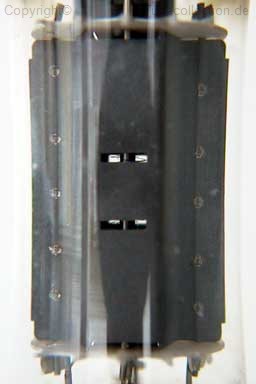 |
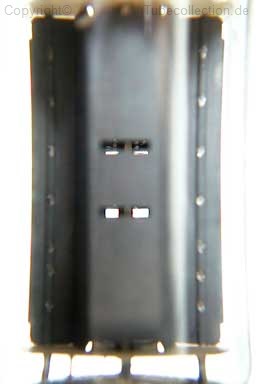 |
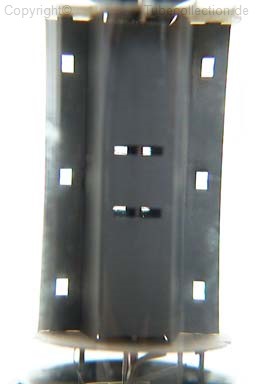 |
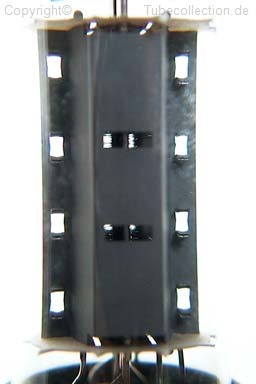 |
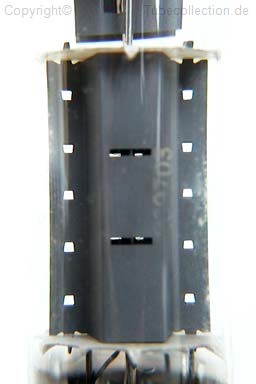 |
| A1. Ränder geschweißt, 2x 5 Punkte. (Anodes welded, 2x5 spots). | A2. Ränder geschweißt 2x 7 Punkte. (Anodes welded, 2x7 spots). | A3. Ränder gekrimpt 2x 3 Löcher. Plates crimped, 2x3 holes). | A4. Ränder gekrimpt 2x 4 Löcher. (Plates crimped, 2x4 holes). | A5. Ränder wechselseitig gekrimpt 2x 5 Löcher. (Anodes crimped reciprocally 2x5 holes). |
|
Eine weitere Unterscheidung ergibt sich bei den Längen der Anodenbleche und bei den darin vorhandenen Schlitzen. Diese verlaufen quer zur Längsachse der Röhre, haben unterschiedliche Abstände voneinander und sind von unterschiedlicher Größe. |
Another distinctive feature is the size of the slots in the anodes and their position. There are small slots about 6x1mm and big slots about 1,7x6mm. They appear as single slot or two in parallel to each other in distances of 8mm and 12mm. |
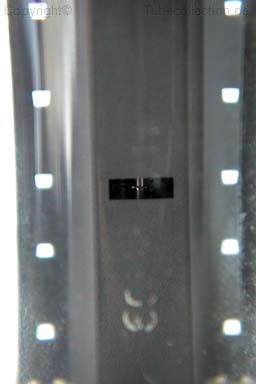 |
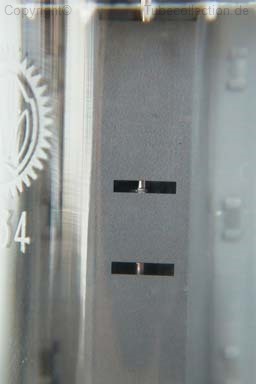 |
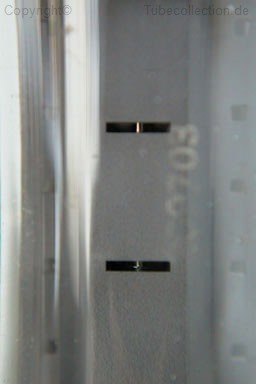 |
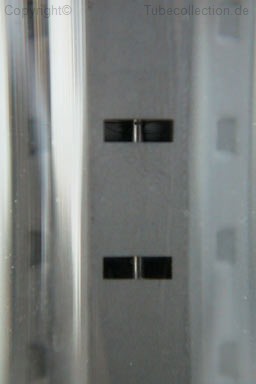 |
| S1. 1 großer Schlitz ca.1,6x6mm Anodenblechlänge ca. 40mm, hier bei TFK 3. (1 big slot ca: 1,6x6mm, anode lengh ca: 40mm, here at TFK3). | S2. 2 schmale Schlitze ca. 6x1mm, Abstand ca. 8mm. Anodenblechlänge ca. 40mm. ( 2 small slots ca: 6x1mm, distance ca: 8mm, anode lengh ca: 40mm). | S3. 2 schmale Schlitze ca. 6x1mm, Abstand ca. 12,5mm. Anodenblechlänge ca. 40mm. ( 2 small slots ca: 6x1mm, distance ca: 12,4mm, anode lenght ca:40mm). | S4. 2 große Schlitze, ca. 1,7x5mm, Abstand ca. 12mm. Anodenblechlänge ca. 38mm. ( 2 big slots, ca:1,7x5mm, distance ca: 12mm, anode lenght ca:38mm). |
|
Kommen wir nun zu den unterschiedlichen Gettern. Hier unterscheiden wir zwischen:
Sie befinden sich bei der EL34 ausnahmslos im Kopfteil der Röhre. Audio-Spezialisten bevorzugen Röhren mit zwei Ringen bzw. zwei D-Getter. |
Coming now to the different getters. There are:
They are all located without any exeption in the top of the tube. Audio freaks prefer mostly 2 halo rings or 2 D-getters. |
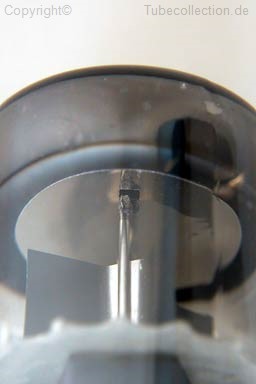 |
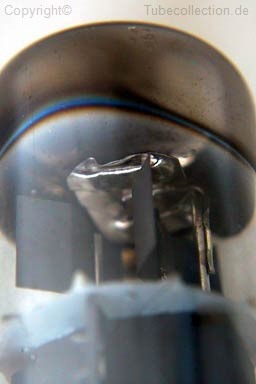 |
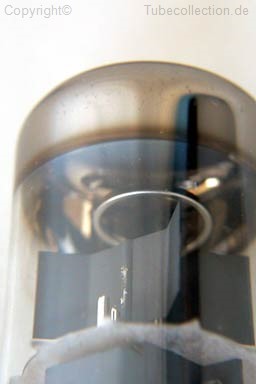 |
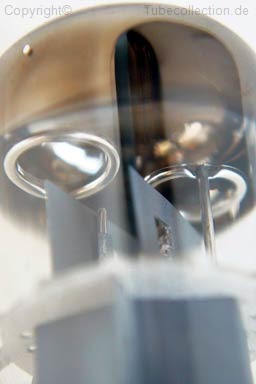 |
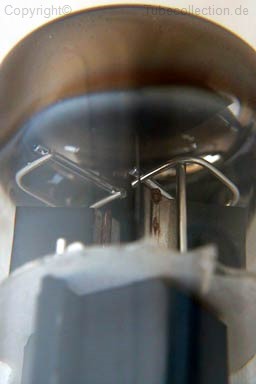 |
| G1. Scheiben- Getter | G2. Platten- Getter | G3. 1x Ring- Getter | G4. 2x Ring- Getter | G5. 2x D- Getter |
|
Dann gibt es noch Unterschiede bei den Sockeln und den Glaskolben. Hier zunächst die Sockel. In der grundsätzlichen Unterscheidung Metall- oder Kunststoff-Sockel. Bei den Kunststoffsockeln wiederum schwarz oder braun und bei den schwarzen noch in der Höhe. Ein weiteres Kennzeichen: hat der Führungsstift in der Mitte eine Loch oder nicht. |
The next differeces are in the bases and the glas bulb. First the bases. The main difference is metelbase with black or brown inserts and solid plastikbases in black and brown. The black bases exist in 2 different hights. Some bases have a centerpin with a hole others don`t have any. |
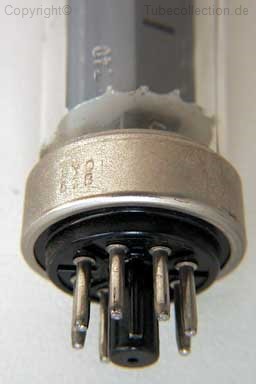 |
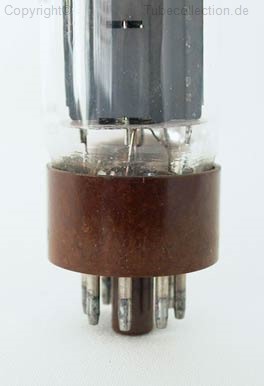 |
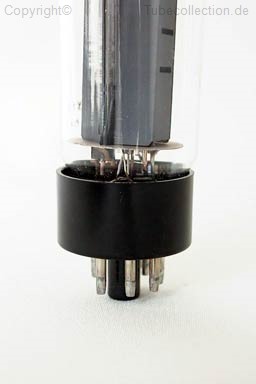 |
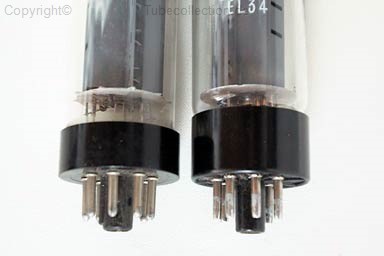 |
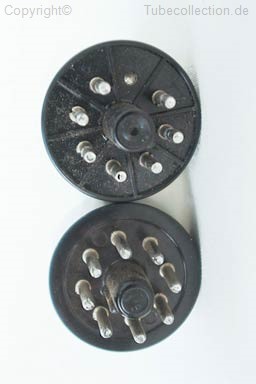 |
| So1. Metall-Sockel ( metal base with black insert) | So2. Kunststoff- Sockel braun (plastik base in brown) | So3. Kunststoff- Sockel schwarz (plastik base in black) | So4. Sockelhöhe unterschiedlich ( different hights at black bases) | So5. Oberer Führungsstift hat Loch in der Mitte.( Upper tube has hole in center pin) |
|
In Bezug auf die Glasform gibt es kaum Unterschiede, außer im Kopf. Hat dieser eine kleine "Delle" nach unten, so wurde die Röhre garantiert in der ehemaligen DDR hergestellt. Weitere Unterschiede gibt es in der Ausgestaltung der Ränder der kopfseitigen Isolierplatten, die das System im Glaskolben zentrieren |
Regarding the glas bulbs are no variations, exept the head. Some have a small dingle downwards. This tube have been produced in East Germany, former GDR. Other variations exist by different shapes of the top and bottom mica insulators. They have different numbers of tips touching the glas bulb. |
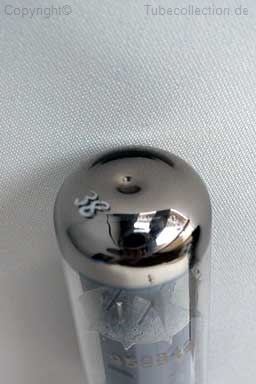 |
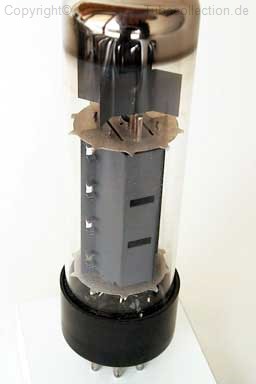 |
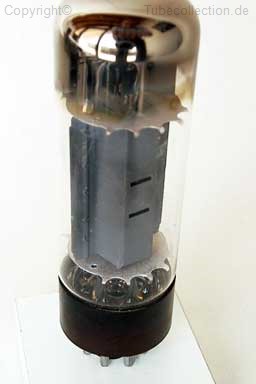 |
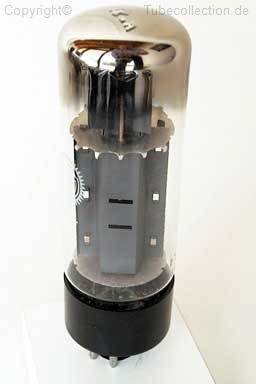 |
|
| K1. "Delle" im Kopf des Kolbens. (dingle in bulb at top) | M1. 10 Zacken unten und oben gleichmäßig am Umfang verteilt. ( 10 tips in equal spacing among each other ) | M2. 2x 5 Zacken oben und unten. (2x5 tips at top and bottom). | M3. 2x 5 Zacken oben, unten keine Zacken. (2x5 tips only at top, at bottom none) |
|
Letztendlich gibt es noch die unterschiedlichen Röhren- Codierungen aus denen der Fachmann erkennen kann, wo und wann die Röhre hergestellt wurde. Nachfolgend einige Fotos von solchen Codierungen. |
At least exist variations by different codes giving experianced insiders any note about the company which produced the tube and the year it gas been made. The following pictures show such codes. |
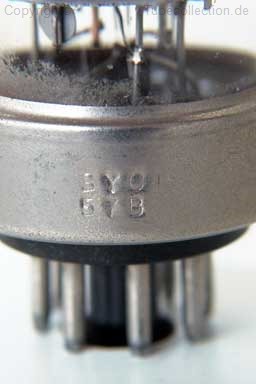 |
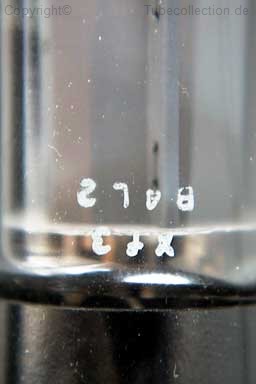 |
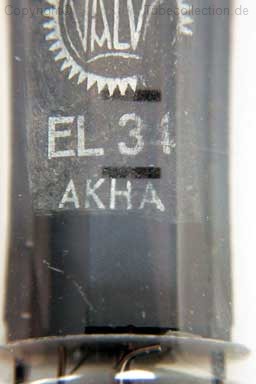 |
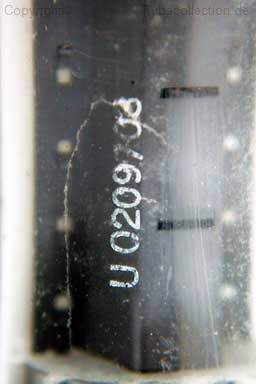 |
|
| C1. Prägung im Metallsockel. (Code stamped in the metal base) | C2. Aufdruck am unteren Rand des Glaskolbens. (print close to the base) | C3. Aufdruck unter der Typenbezeichnung (Valvo). ( Code printed just below the type). | C4. Seitlicher Audruck bei Telefunken. (vertical code at Telefunken tubes) |
|
Als nächstes werde ich eine Tabelle mit all den vorgenannten Merkmalen zusammenstellen und anschließend mit Röhren verschiedener Marken vergleichen. Mit dieser Tabelle sollte es dann später möglich sein, Röhren mit abgewischter Aufschrift wieder einwandfrei zu identifizieren. |
Next I´m going to establish a table with the 16 investigated tubes in head. Below left I refer to all the differences that I could detect. Then I have colored the cells when a special brand comes across with that details. So I think it will be now possible to check any EL34 tube by this table and to find out which company could have produced it. |
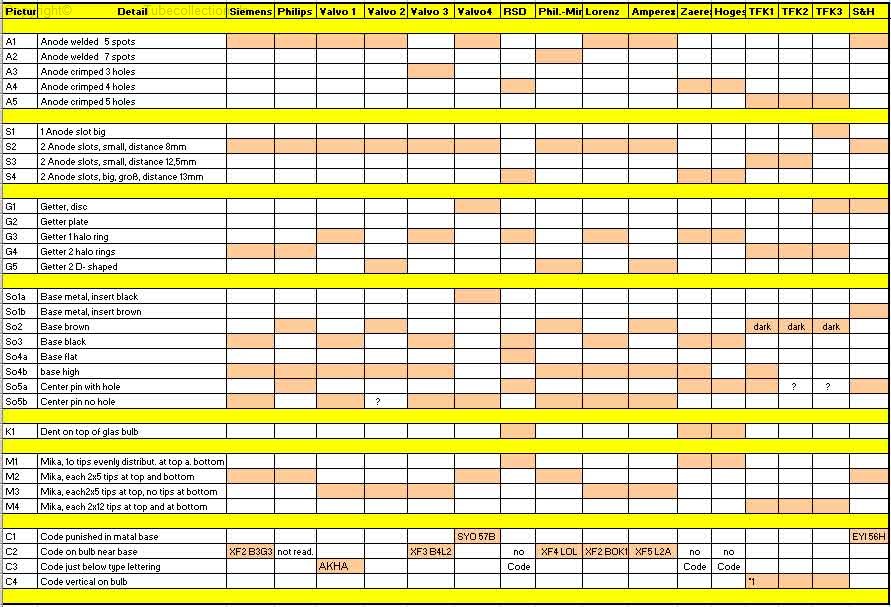

|
Es wäre mal interessant, auch noch weitere Röhren nach diesem Muster zu checken, um eine noch größere Sicherheit zu erlangen. |
It would be intereting to check mor EL34 tubes by this matrix to get more safe. |
|
Sollte jemand eine Fehler finden oder etwas zu ergänzen haben, so bitte ich um eine Mail.
Home |
 |
In case there is something incorrect or should be added, please send me a mail. |